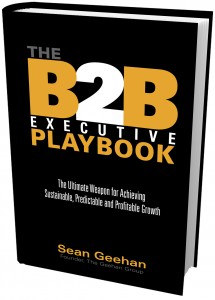 So, you think your company is customer-focused? If you’re not involving the top executives of your top accounts in your planning, you’re not as customer-focused as you could be. While every B2B company pays lip service to customer focus, few go as far as the prescriptions in The B2B Executive Playbook: The Ultimate Weapon for Achieving Sustainable, Predictable and Profitable Growth
So, you think your company is customer-focused? If you’re not involving the top executives of your top accounts in your planning, you’re not as customer-focused as you could be. While every B2B company pays lip service to customer focus, few go as far as the prescriptions in The B2B Executive Playbook: The Ultimate Weapon for Achieving Sustainable, Predictable and Profitable Growth, by Sean Geehan, to make it a reality.
In B2B sales, there is a surprisingly small group of individuals who hold the most control over your fate—your revenue, profitability and market share. They are the executive decision makers of your best customers.
- How often do you talk to them?
- How well do you really know what they think about your company and your offerings?
- Do you know exactly why they buy from you?
- Does your perception of your strengths and weaknesses jibe with theirs?
- If you picked up the phone to call each one, what would happen?
This last question is taken from page 95, which in itself is worth the price of the book. Geehan provides a simple assessment you can use to figure out where you stand on the B2B relationship continuum, which has five descriptions ranging from Commodity Supplier to Business Partner. The phone call test for each one is simple and powerful—and if you answer it honestly, you probably will be disturbed by the result.
The theme of the book is about how to achieve sustainable, predictable and profitable growth (SPPG) through close and active engagement with your top executive customers. While this may not seem like a huge revelation, very few companies do it well, and the value in this book consists of its specific four-step plan for how to accomplish this.
Engage: “Engagement means executive customers are talking to your leadership team directly and without filters.” In this section, Geehan explains how to establish and use an Executive Customer Advisory Council (ECAC) to get your top customers engaged in the process, and whom to include. Because they are the ones who write the really big checks, you can’t leave it entirely in the hands of your account managers; your own executive leadership must be continuously and deeply engaged with them.
Plan: Every company has a strategic planning process, in which they make decisions about strategy, products, markets, resource allocation, etc., but very few involve the stakeholders who vote with their dollars to approve or disapprove of their plans. Geehan advocates Market-Aligned Planning, which uses customer input to help identify which strategies to eliminate, evolve, or acquire.
Collaborate: Most companies equate relationship-building with entertainment. Geehan recommends a much deeper process called Account-Based Innovation, which uses customer inputs to inform choices about R&D and make innovation relevant (and worthwhile). Companies have long learned to minimize internal silos that slow down innovation—this process eliminates the last remaining silo, that between companies and their customers. 60-70% of new products in the B2B space fail; why not give the customer a voice before the cost, trouble and time go into the launch?
Grow: When customers have an early and active role in your planning processes, they often become your best salespeople within their industries. The book cites the example of Henny Penny Corporation, which used the process to design a low oil volume fryer for McDonald’s. That breakthrough led to their being named Worldwide Equipment Partner[1] of the Year in 2010, and that kind of publicity was priceless for other customers.
This book is not for everyone: it’s clearly aimed at those within the company who have primary responsibility for revenue growth. It offers offers clear, direct prescriptions, backed by numerous examples that provide credibility and illumination to the author’s thesis. If you want to listen to the Voice of the Customers that really matter, this book will show you how.


